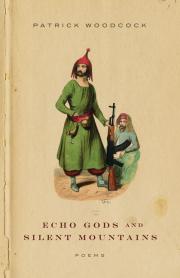 Echo Gods and Silent Mountains
Patrick Woodcock
ECW Press, 2012
Echo Gods and Silent Mountains
Patrick Woodcock
ECW Press, 2012
Review by BJ Soloy
At the end of the first section of Echo Gods and Silent Mountains, Patrick Woodcock’s eighth book of poetry, the poem “Fourteen Postcards” stands as something of a microcosm for the book’s greater project. Addressing (among other characters) feral dogs, sandstorms, and children laughing until they cry, the poem embodies a composite apostrophe: a collage of characters and scenes converging into a cumulative sense of a place and its people. The place, in this instance, is the Kurdish region of northern Iraq, and the people are its inhabitants: a woman with disappeared husbands and brothers, a stubborn translator, the deputy head of the dwarf society, the attentive and conflicted Canadian poet in the middle of it all. Through their voices and stories, Woodcock offers readers an accounting of a place that is often reduced to regional footnote of an American war, if noted at all. Woodcock, whose previous books have been written from locations as diverse as Colombia, Sarajevo, and Russia, seems determined to challenge the reduction used to enable such footnoting.
The thematic unity underlying the collection allows for a plurality of formal and narrative approaches. The first section of the book, simply “Echo Gods,” gives voice to its many characters by employing forms both rigid and loose, including a sonnet, a variation on a pantoum, adaptations of open forms with elaborate rhyme schemes, rhyming couplets interrupted by a chorus, and variations on blank or free verse. A standout in this section, “White Boots,” displays the tension and strange harmony at the intersections of form/content and insider/outsider. Its 56 tercets take the reader on an internally-narrated, hungover tour through a museum of atrocities, and the rendering of such an experience makes such a tour neither familiar nor easy.
“Silent Mountains,” the second section, decidedly takes a step back from the formal lyric to offer a nine-page prose poem, which claims that “dialogue here flies in / all directions like hail off a basketball.” This longer poem more concretely enacts the simultaneity of voices, events, and observations with the casual diligence and pace of a traveler’s log.
The third section is a persona poem elegizing a Kurd writer, “Sardasht Osman Is Not Dead,” which opens, “Mother, they put two bullets in my mouth / yesterday. Now I hold them both in my hands,” and ends with, “I am not dead. I am not dead. I am / only dead if our generators fail.” These declarations bookend a piece exhibiting the poet’s ability to negotiate both urgency of voice and profundity of political context while maintaining the ear and eye of an artist; no small feat.
Throughout the collection, Woodcock exercises a Whitmanian mobility of identity and scope while resisting the urge to play tourist or missionary. His social sensitivity and political acumen are tempered by a self-conscious humor and a bent towards the vulgar mundane that transcend platitudes and slogans. In “The Teahouse,” he says, “It is exciting to listen to the birth of a nation. / It is wonderful to absorb the several.” Through its amalgamation of voices, forms, and ideas, and through its earnest craft and composite apostrophe, Echo Gods and Silent Mountains refuses the reduction to the simple and delivers the excitement of the several.
---
Patrick Woodcock is the author of eight books of poetry. He was the poetry editor for the Literary Review of Canada and has published extensively in Canada, the U.S., England, India, Colombia, and the Middle East. Because travel is so essential to his writing, he has lived everywhere from Iceland to Russia, Bosnia and Herzegovina to Oman, Saudi Arabia, and Iraq. He currently resides in Fort Good Hope, Northwest Territories.
BJ Soloy is exactly 1/3 of the anachronistic prog-yawp outfit "Dear Sister Killdeer," and has had poems published in Colorado Review, Court Green, MipoEsias, Columbia Poetry Review, Starting Today (University of Iowa Press) and DIAGRAM, among others.
